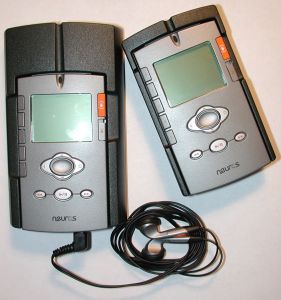
| Gadgeteer Hands
On Review : Neuros MP3 Digital Audio Computer by Julie Strietelmeier Date: 04/10/2003 Let us know your comments on this review and read what others have to say. |
Product Requirements:
Device:
Microsoft� Windows 98SE/Me/2000/XP
USB port
MP3 players are fantastic when you want to carry a couple hours of music with you while you're on the go. But how do you carry your entire music collection with you instead of just a couple albums? I bet you immediately thought of the ever popular iPod player from Apple... I'm actually going to take a look at a different 20 gigabyte player today. The Neuros MP3 Digital Audio Computer from Digital Innovations. Available in 128mb and 20gig versions, this player has a few features that the iPod doesn't, along with a cheaper price tag. . Let's take a closer look.

Hardware Specifications:
Capacity: 2 Hours of music, 20GB hard drive holds up to 5,000 songs (encoded
at 128kbps)
Display: 2-inch (diagonal) LCD with orange LED backlight, 128 by 128 pixel
resolution, .21/.28 dot pitch 4 level gray scale
128mb Version Size (with backpack): 4.3 x 2.5 x 1.3" (10.9 x 6.3 x 3.3cm),
Weight: 5.8oz. (164 g)
20gb Version Size (with backpack): 5.3 x 3.1 x 1.3" (13.4 x 7.8 x 3.3cm),
Weight: 9.4oz. (266 g)
Audio: Maximum output power: 60mW rms (30 mW per channel)
Frequency response: 20 Hz to 20,000 Hz
MP3 format: (up to 320 kbps), MP3 Variable Bit Rate (VBR)
Recording: 64-160 kbps MP3 format
3.5mm stereo headphone jack
3.5mm stereo line-in jack
2.5mm stereo RF jack (for external antenna)
AC Power Adapter: input: 100V to 125V at 0.4, frequency: 50 to 60Hz, DC output:
9V at .8 amp
USB 1.1
I've been interested in large capacity MP3 players for a long while now.
However, I haven't been brave enough to fork over $500 for an iPod without
testing one first. I was very happy when Digital Innovations responded to my
request for an evaluation unit of their Neuros player. They actually sent me the 128mb version first,
and after I begged, they sent me the 20gb version as well. I must say that the
folks at Digital Innovations are very responsive and great to work with!
When I first received the 128mb version, I was surprised at its size. Most 128mb players that I've looked at in the past have been pretty small. Actually, the Neuros player itself is small and thin, but it requires a backpack in order to work. This design makes the Neuros quite a bit more bulky than I am used to. Then I received the 20gb version and thought "wow, this thing is really a brick". During the couple of weeks that I've been using both units, their size has grown on me. But I would still prefer them to be smaller. Especially the 20gb version.
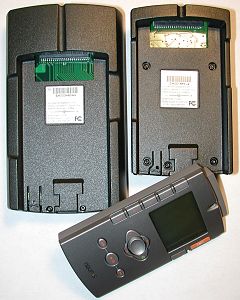
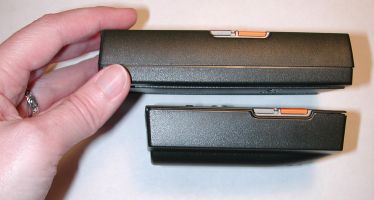
The Neuros player is made of grey plastic. It is very light and thin. At the top is a 50 pin connector that plugs into the backpack. Inserting and removing the player from the backpacks is a little difficult, but it isn't something you'll be doing very often... if at all. The player with the pack is a sturdy combination. Both packs are made of thick black plastic that don't flex when squeezed. That said, I wouldn't want to drop the Neuros on to a hard surface... especially the 20gb version. The 128mb version comes with a removable belt clip, while the 20gb version does not.
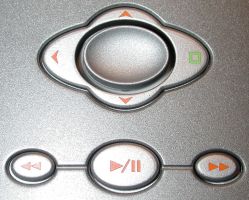
The front of the player has 10 buttons and a 4 way joystick style button in the middle. 5 buttons along the left side of the unit are for your 5 favorite radio station presets. Across from these buttons is the HiSi (Hear it Save it) / Record button and the button lock switch. The buttons at the bottom of the unit give you your standard Previous, Play/Pause and Next features, and the 4 way button in the middle allows you to scroll and select features via the onscreen menus. The Play/Pause button also doubles as the Power button by pressing and holding it for several seconds. All of the buttons are easy to press and have good tactile feedback. The 4 way button is concave so that your thumb can rest in the center and not slip as you navigate thru song lists and menus.
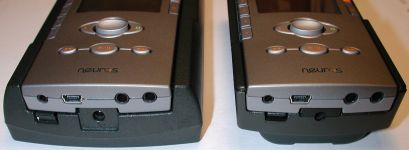
At the bottom of the player is an RF jack, USB connector, earphone connector and Line-in jack. Built into the pack is an AC adapter connector. There is a NiMH rechargeable battery built into the 128mb pack, and a Lithium Ion rechargeable pack built into the 20gb version. Both packs take approximately 8hrs to charge using an included AC adapter. Once charged, they will play about 10hrs. I can verify that the 20gb version will play that long. I let it charge overnight, unhooked it from the power around 6:30am. Turned it on at 8:45am and didn't turn it off until 8hrs and 45mins later when it turned itself off due to a low battery. One thing missing battery-wise is a charging status LED. As it is, you have no real way of knowing when the battery is fully charged without turning the player on to check the onscreen battery status icon.
The display on the Neuros is a nice size and is easy to read indoors or out. The display is very mono Palm-like, and even has a contrast adjustment setting. There is also an amber backlight that you can turn on for 10 or 30 seconds whenever a button is pressed. This is great when you're in a dimly lit area and need to change settings or choose a song.
The Neuros player interface is simple but effective. It isn't one that will require you to read a manual to figure out. The main menu that greets you when you turn on the unit has five choices: Neuros Audio, FM Radio, HiSi, PC Library and Settings.
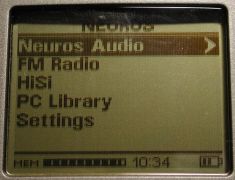
The Neuros Audio menu is where you'll probably spend most of your time. It is here where you choose individual songs to play, or search by play list, artist, albums, genres or recordings. Choosing the songs heading will list all the songs saved on the 20gb hard drive in alphabetical order. As you can imagine, scrolling through thousands of songs can take awhile. Scrolling speed remains constant even if you hold the up/down scroll button. One thing I didn't really like was the fact that once you reach the end of the listing, it automatically scrolls back to the top and keeps going.
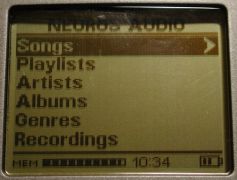
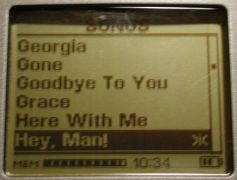
Most people probably won't choose to play all their songs individually. Instead, they will either create play lists, or will play an album at a time. Luckily, you can quickly scroll through your play lists, album lists, artist lists and genres. When you see the album name or artist name you want to listen to, you just press play and then sit back and enjoy the tunes. I really like being able to search by artist. If you have multiple albums by one person or band, you can easily play all their songs just by pressing play on their name. Otherwise, you can quickly zero in on one song if you desire. You also have standard shuffle and repeat settings.
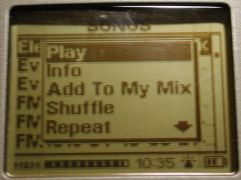
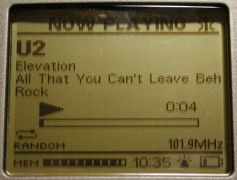
It is also important to point out that you can delete songs from the player and add songs to the internal play list on the player called MyMix. I did find one thing that might be considered a bug. You can actually add songs multiple times to MyMix.
The audio quality on the Neuros is probably the best of any MP3 player that I've had the chance to use or review so far. Although there isn't a built-in equalizer that you can adjust, I've found the player to produce great sound for all types of music that I've thrown at it. As a matter of fact, I really hate to send this unit back to them because I love listening to it so much <sniff>.
The PC Library feature which is available from the main menu is pretty cool and really sets this player apart from all others. Say you have a bazillion MP3s on your PC and don't necessarily want to copy all of them to the Neuros. Now, imagine that you're away from your PC and are listening to your Neuros and think of a song that is on your PC, but not the Neuros. You go to the PC Library feature on the player and boom, you can now search through your entire music catalog that resides on your PC. When you see the song that you want, you can select it and have it added to the MyMix play list, or to the song list. The next time you sync with your PC, it will copy that file to the Neuros automatically!
The FM Radio feature on the Neuros, gives you just that, an FM radio. You even can assign your 5 favorite radio stations to the 5 buttons on the left side of the player. You can scroll through stations starting at 87.5MHz and going up to 107.9MHz. The reception really varies depending on your location. The player uses the cord on the ear buds as an antenna. I think the player would benefit greatly from a better antenna. There is an RF connector on the bottom of the player, but so far the option isn't available from Digital Innovations.

Another really cool feature of the Neuros is the ability to find out who is singing a song that you hear playing on a radio station. If you want more info about a song while it is playing, you just press the orange HiSi (otherwise know as Hear it! Save it!) button. It records a 30 second snippet. Then when you sync with your PC, it looks the song up on an internet database and gives you the song time, artist name and date the song was recorded. Pretty freaking nifty!

Click on thumbnail for full-size image
You aren't limited to only recording 30 second sound bites from the radio, you can record as long as you like. By pressing the orange HiSi button twice, it will record until you press the button a third time, switch stations, or press the left direction on the joy pad. I think this feature should be expanded to include timed recordings. It would be so cool to have VCR-like capability on the Neuros. I have a friend that really enjoys NPR (National Public Radio), but he doesn't always have time to listen to different broadcasts. Recording them for later enjoyment would really be a great feature.
You can also use the Neuros as a voice recorder. There is a built in microphone above the display, or you can plug in a microphone or a device with an audio output into the Line-in jack at the bottom of the player. You have the ability to define the quality of the MP3 recordings by choosing from sample rates of 64, 96, 128 or 160 Kbps. The higher the sample rate, the more storage a recording will consume. To give you an idea, 64 Kbps uses 500KB per 1 minute and 160 Kpbs uses 1.25 MB for the same duration.
Besides receiving radio broadcasts, you can also transmit your music to the radio. Yes, you read that right, you can transmit from the Neuros to an FM frequency. This built-in feature is pretty much identical to the irock! wireless music adapter that we have reviewed here on the Gadgeteer. The Neuros can scan for an optimal transmitting frequency, or you can choose one yourself. Once you have it setup, you can then set the player in your car seat and listen to your music through your car stereo. Transmit range is supposed to be 10 - 20 feet, but I found it to be more along the lines of 5-6ft in the areas I tested (from my car and in my living room). Audio quality is fair to good. It's definitely not going to sound as good as it does when listening directly through the ear buds. I was surprised though at how well it sounded through my stereo.
One thing that I would love to see, is the ability to broadcast the radio playing on the Neuros through the radio in your car or stereo. That way, if you like to listen to the radio while you're driving to work, and hear a song that you want more info about, you can press the HiSi button to record the snippet. I'm sure that doing so is an FCC no-no, but I think it would be cool. I guess you could get a separate transmitter like the irock! to use in those situations.
On the PC side of things, there is the Neuros Synchronization Manager. This is a pretty basic application that allows you to sync / copy MP3 files to and from the Neuros, setup play lists and resolve HiSi requests. Using USB 1.1, you connect the Neuros to a free port. As soon as it is connected, the Neuros will power on and initiate a sync. It will copy any HiSi requests up to the PC and grab any new music from the PC Library that you may have requested from the Neuros. It will also check to see if there are new firmware or updates to the desktop application that need installed. Although the device doesn't use faster methods like Fire wire or even USB 2.0, the file transfers speeds are pretty good. A typical 12 song album takes approximately 2 minutes to transfer to the Neuros. The only thing missing from the PC software is CD ripping features.


Click on thumbnail for full-size image
After using the Neuros for the past few weeks, I have to say that I really
want a large capacity player now. Having ALL my music with me all the time has
become important to me. Although the Neuros is bulkier than the iPod, it has
several features that make it desirable. First of all, it is $100 cheaper, has a
built in FM radio, voice recorder, FM transmitter and the ability to identify
songs played on the radio. If I was in the market to buy a 20gb player, I would
be hard pressed to find one with as many interesting features as this one. One
the other side of the coin, if I was looking for a 128mb player, I think I would
have to pass on the Neuros. Even with the extra features, the limited storage
space would be the main turn off for me. I think Digital Innovations should
really consider adding an SD or CF slot to the player.
Price: $249 128mb version, $399 20gb version
Pros:
Big display
Built in radio, voice recorder and FM transmitter
Song ID feature
Cons:
128mb version is bulky and lacks an expansion slot for SD or CF
20gb version is bulky
Does not support music formats other than .MP3 at this time
CD ripping software not included
Lack of battery charging status LED
| Let us know your comments
on this review and read what others have to say. Back to Main Page. |